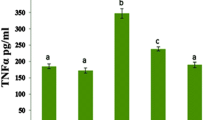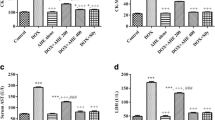Abstract
Drug-induced cardiotoxicity is a significant concern in cancer patients, and therefore cardio-oncology is gaining more attention. Doxorubicin (Dox) is a potent anticancer drug used against various malignancies, with cardiotoxicity as a dose-limiting factor. Although the mechanism of Dox-mediated cardiotoxicity is not fully understood, it is thought to encompass oxidative stress during the therapy leading to cardiotoxicity in cancer patients. Several oxidative stress-induced diseases and drug-induced toxicities can be effectively ameliorated using bioactive plant constituents. Dillenia indica (DI) is one such plant belonging to the family Dilleniaceae and is used as an ethno-medicinal agent for the treatment of various oxidative stress-mediated diseases like diabetes and cancer. In this study, we have evaluated the protective effect of the hydroalcoholic extract of Dillenia indica fruits (HADI) against the Dox-induced cardiomyocyte toxicity. The HADI was further evaluated for its efficacy in a Dox-induced cardiotoxicity models. Antioxidant assays (ABTS and DPPH) revealed a strong antioxidant potential of HADI. In vitro assay results indicated that pre-treatment with HADI had shown protective activity and reduced the ROS generation in H9c2 cell line. Non-invasive methods like high-frequency ultrasonography and electrocardiography were applied to evaluate the real time cardiac parameters. It was also found that pre-treatment with HADI restored functional parameters like ejection fraction, stroke volume as well as elevation of the T wave induced by Dox. Whereas the Dox treated mice had elevated levels of cardiac functional enzymes like creatinine kinase (CK-MB) and lactate dehydrogenase indicating the severity of cardiomyocyte toxicity. The results indicated that HADI pre-treatment has significantly reduced the upregulated enzyme levels. Taken together, our findings indicated that HADI ameliorated the Dox-induced cardiomyocyte toxicity by modulating the upregulated reactive oxygen species.





Similar content being viewed by others
Abbreviations
- DPPH:
-
2,2-Diphenyl-1-picrylhydrazyl
- ABTS:
-
(2,2′-Azino-bis(3-ethylbenzothiazoline-6-sulfonic acid))
- DCFDA:
-
2′,7′-Dichlorofluorescin diacetate
- DNTB:
-
(5,5′-Dithio-bis-[2-nitrobenzoic acid])
- CK-MB:
-
Creatine kinase-MB
- LDH:
-
Lactate dehydrogenase
References
Abramovič H, Grobin B, Ulrih NP, Cigić B (2017) The methodology applied in DPPH, ABTS and Folin–Ciocalteau assays has a large influence on the determined antioxidant potential. Acta Chim Slov 64:491–499
Appidi T et al (2020) Light-triggered selective ROS-dependent autophagy by bioactive nanoliposomes for efficient cancer theranostics. Nanoscale 12:2028–2039
Biswas S, Pandita N (2015) Phytochemical analysis and chromatographic evaluation of alcoholic extract of Dillenia indica Linn. leaves. Int J Pharm Sci Res 6:2799
Biswas R, Chanda J, Kar A, Mukherjee PK (2017) Tyrosinase inhibitory mechanism of betulinic acid from Dillenia indica. Food Chem 232:689–696
Cadenas E (2004) Mitochondrial free radical production and cell signaling. Mol Asp Med 25:17–26
Challa VS, Vegi GMN, Asha S (2019) An evaluation of antioxidant potential of Memecylon sisparense gamble leaf in doxorubicin-induced cardiotoxicity in mice. Curr Trends Biotechnol Pharm 13:41–49
Chandran K et al (2009) Doxorubicin inactivates myocardial cytochrome c oxidase in rats: cardioprotection by Mito-Q. Biophys J 96:1388–1398
Deavall DG, Martin EA, Horner JM, Roberts R (2012) Drug-induced oxidative stress and toxicity. J Toxicol. https://doi.org/10.1155/2012/645460
Fridlender M, Kapulnik Y, Koltai H (2015) Plant derived substances with anti-cancer activity: from folklore to practice. Front Plant Sci 6:799
Fu C, Yang D, Peh WYE, Lai S, Feng X, Yang H (2015) Structure and antioxidant activities of proanthocyanidins from elephant apple (Dillenia indica Linn.). J Food Sci 80:C2191–C2199
Giustarini D, Rossi R, Milzani A, Dalle-Donne I (2008) Nitrite and nitrate measurement by Griess reagent in human plasma: evaluation of interferences and standardization. Methods Enzymol 440:361–380
Hwang J-T, Kwon DY, Park OJ, Kim MS (2008) Resveratrol protects ROS-induced cell death by activating AMPK in H9c2 cardiac muscle cells. Genes Nutr 2:323–326
Kaur N, Kishore L, Singh R (2016) Antidiabetic effect of new chromane isolated from Dillenia indica L. leaves in streptozotocin induced diabetic rats. J Funct Foods 22:547–555
Khoubnasabjafari M, Ansarin K, Jouyban A (2015) Reliability of malondialdehyde as a biomarker of oxidative stress in psychological disorders. BioImpacts 5:123
Kumar S, Kumar V, Prakash O (2011) Antidiabetic, hypolipidemic and histopathological analysis of Dillenia indica (L.) leaves extract on alloxan induced diabetic rats. Asian Pac J Trop Med 4:347–352
Lawson M, Jomova K, Poprac P, Kuča K, Musílek K, Valko M (2017) Free radicals and antioxidants in human disease. In: Nutritional antioxidant therapies: treatments and perspectives. Springer, pp 283–305
Lu J, Holmgren A (2014) The thioredoxin antioxidant system. Free Radic Biol Med 66:75–87
Mladěnka P et al (2018) Comprehensive review of cardiovascular toxicity of drugs and related agents. Med Res Rev 38:1332–1403
Olabinri B, Odedire O, Olaleye M, Adekunle A, Ehigie L, Olabinri P (2010) In vitro evaluation of hydroxyl and nitric oxide radical scavenging activities of artemether. Res J Biol Sci 5:102–105
Owen JB, Butterfield DA (2010) Measurement of oxidized/reduced glutathione ratio. In: Protein misfolding and cellular stress in disease and aging. Springer, pp 269–277
Pugazhendhi A, Edison TNJI, Velmurugan BK, Jacob JA, Karuppusamy I (2018) Toxicity of Doxorubicin (Dox) to different experimental organ systems. Life Sci 200:26–30
Renu K, Abilash V, PB TP, Arunachalam S, (2018) Molecular mechanism of doxorubicin-induced cardiomyopathy—an update. Eur J Pharmacol 818:241–253
Songbo M, Lang H, Xinyong C, Bin X, Ping Z, Liang S (2019) Oxidative stress injury in doxorubicin-induced cardiotoxicity. Toxicol Lett 307:41–48
Sridhar K, Charles AL (2019) In vitro antioxidant activity of Kyoho grape extracts in DPPH and ABTS assays: estimation methods for EC50 using advanced statistical programs. Food Chem 275:41–49
Štěrba M, Popelová O, Vávrová A, Jirkovský E, Kovaříková P, Geršl V, Šimůnek T (2013) Oxidative stress, redox signaling, and metal chelation in anthracycline cardiotoxicity and pharmacological cardioprotection. Antioxid Redox Signal 18:899–929
Sun Z, Lu W, Lin N, Lin H, Zhang J, Ni T, Meng L, Zhang C, Guo H (2020) Dihydromyricetin alleviates doxorubicin-induced cardiotoxicity by inhibiting NLRP3 inflammasome through activation of SIRT1. Biochem Pharmacol 27:113888
Tak T, Jaekel CM, Gharacholou SM, Dworak MW, Marshall SA (2020) Measurement of ejection fraction by cardiac magnetic resonance imaging and echocardiography to monitor doxorubicin-induced cardiotoxicity. Int J Angiol 29:045–051
Valko M, Jomova K, Rhodes CJ, Kuča K, Musílek K (2016) Redox-and non-redox-metal-induced formation of free radicals and their role in human. Arch Toxicol 90:1–37
Van Meerloo J, Kaspers GJ, Cloos J (2011) Cell sensitivity assays: the MTT assay. In: Cancer cell culture. Springer, pp 237–245
Yan T, Deng S, Metzger A, Gödtel-Armbrust U, Porter AC, Wojnowski L (2009) Topoisomerase IIα-dependent and-independent apoptotic effects of dexrazoxane and doxorubicin. Mol Cancer Ther 8:1075–1085
Yeshwante S, Juvekar A, Nagmoti D, Wankhede S, Shah A, Pimprikar R, Saindane D (2009) Anti-inflammatory activity of methanolic extracts of Dillenia indica L. leaves. J Young Pharm 1:63
Zambelli A, Della Porta MG, Eleuteri E, De Giuli L, Catalano O, Tondini C, Riccardi A (2011) Predicting and preventing cardiotoxicity in the era of breast cancer targeted therapies. Novel molecular tools for clinical issues. The Breast 20:176–183
Acknowledgements
The authors would like to acknowledge the Department of Pharmaceuticals (DOP), India. We would also like to acknowledge the National Mission On Himalayan Studies (NMHS), G.B Plant National Institute of Himalayan Environment and Sustainable Development (GBPNIHESD), India. Ref No: GBPI/NMHS-2017-18/HSF-02.
Author information
Authors and Affiliations
Corresponding authors
Ethics declarations
Ethical statement
The study was approved by the Institutional Animal Ethics Committee (IAEC), Guwahati, India (NIPS/NIPER/18/02).
Conflict of interest
Kalyani Tene has no conflict of interest. Kalyan Kumar has no conflict of interest. Deepak Bharadwaj Pemmaraju has no conflict of interest. Jagadeesh Kumar has no conflict of interest. P. A. Shantanu has no conflict of interest. Ranadeep Gogoi has no conflict of interest. V. G. M. Naidu has no conflict of interest.
Additional information
Publisher's Note
Springer Nature remains neutral with regard to jurisdictional claims in published maps and institutional affiliations.
Electronic supplementary material
Below is the link to the electronic supplementary material.
Rights and permissions
About this article
Cite this article
Tene, K., Kumar, K., Pemmaraju, D.B. et al. Ameliorative effect of Dillenia indica fruits against doxorubicin-induced cardiomyocyte toxicity. ADV TRADIT MED (ADTM) 21, 805–814 (2021). https://doi.org/10.1007/s13596-020-00510-1
Received:
Accepted:
Published:
Issue Date:
DOI: https://doi.org/10.1007/s13596-020-00510-1




